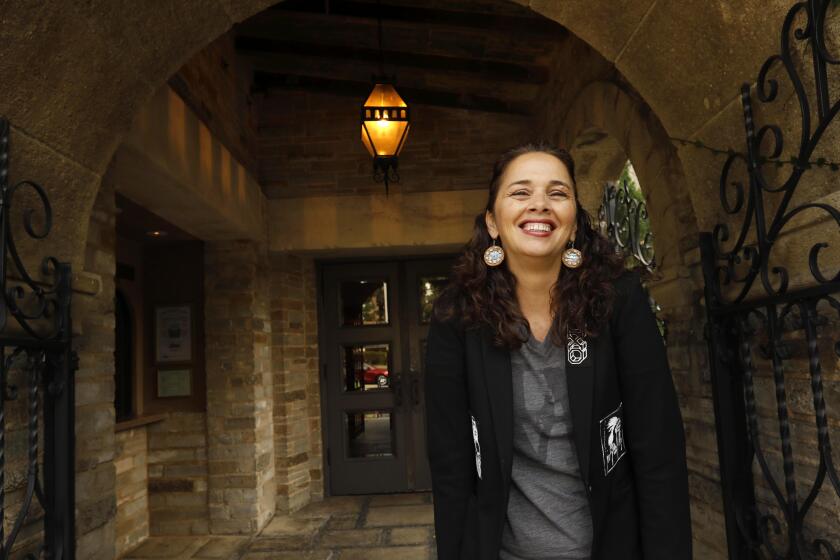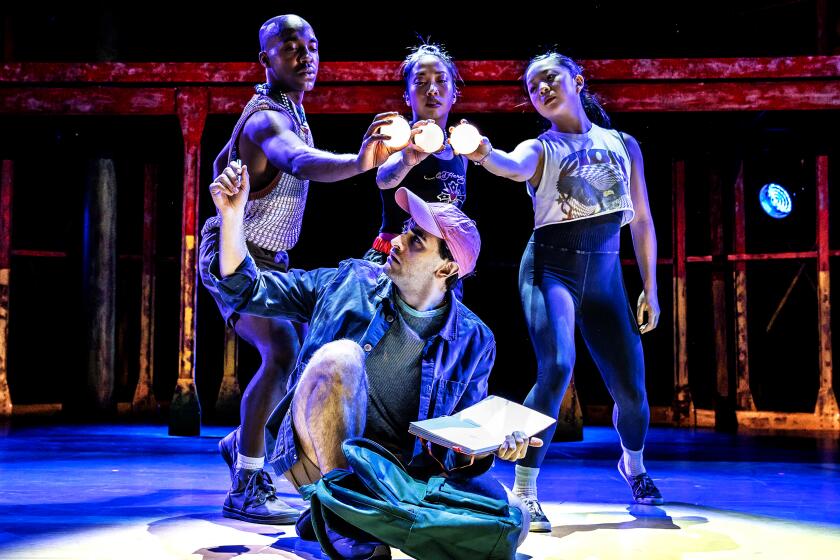Review: Youthful ‘Traces’ spins into the Dorothy Chandler Pavilion
Installing the subversive, off-Broadway theatrical circus “Traces” on the deep proscenium stage of the Dorothy Chandler Pavilion tossed some extra challenges at this high-flying production.
The 90-minute acrobatic work by Montreal-based 7 Fingers was featured as part of the Glorya Kaufman Presents Dance series.
Seen in 2011 at Hollywood’s smaller Ricardo Montalban Theater, “Traces” couldn’t help but sacrifice some of its accidental, downtown flavor in the Music Center’s 3,000-plus-seat hall. On opening night of a three-day run, at least one of the performers (Xia Zhengqi ) seemed thrown off by the space, valiantly redoing his ridiculously difficult multi-level hoop dives until they came out clean.
PHOTOS: Arts and culture in pictures by The Times
The scale that might have balanced between two disciplines was tipped firmly from dance to cirque.
Director/choreographers Shana Carroll (she also did Cirque du Soleil’s “Iris”) and Gypsy Snider (who staged the circus in the new Broadway revivial of “Pippin”) created this blend of Chinese circus arts, basketball, skateboarding, dance and narrative for a group of young students back in 2006. And though it had two somewhat dangling sections — a thrashing, chair-tossing Euro-style opening number and a penultimate “American Idol”-type competition scene — the core of the work committed to an honest portrait of youth sensibility that earned props for its choreographic valor.
The seven multi-disciplinary artists of “Traces” portrayed “themselves” as a cast of characters living and playing moment-to-moment, self-mocking, dropping one activity for another (piano, draftboard, basketballs, diabolos). Between action scenes, moments of spoken word and song evoked intimacy and personality — yet were never responsive to the bravura on hand.
Performers announced biographical facts (height, weight, birthplace, a trio of personal qualities such as “stubbornness” or “flirtatious”); at another point a lone guitarist sang a quiet love song.
When a radio broadcasted news of life-threatening atomic detonation, followed later by a visual cue of a coming tsunami, only the environment showed signs of distress. The kids just built their next round of play around sirens, flashing lights and chalk body outlines.
CHEAT SHEET: Spring Arts Preview
Personal emotional scenes were equally impermanent, as when large, immensely likable Mason Ames hooked up with Valérie Benoît-Charbonneau in a tender, aerodynamic hand-to-hand duet that evaporated once it was over.
Yet a propulsive, screwball bond remained steadily within the crew. Between masterful, distinctive movement episodes — Bradley Henderson’s ride inside a Cyr Wheel, LJ Marles’ strap work and Mathieu Cloutier’s pole dives — the group would also embark on choreographed scenes of shoving, rolling, flipping and sliding, as if some magnetic force attracted and then scattered them.
A restless edge eroded the traditional celestial aura of the cirque scenes, as when Phillipe Normand-Jenny, after catapulting gloriously from the teeter board, ran across the stage to butt his head into the mattress that caught him.
On a concert stage, especially in the frame of dance programming, the preference becomes one for quieter moments of technical mastery as opposed to flamboyant challenges brought to a shaky completion. Yet in a committed paean to youth — for better or worse — the premium will be on the next shiny thing, even if it’s an act of physical daring neither reliable nor completely comprehended.
That seemed to be the reason why the performers rarely smiled after their huge feats of aerial strength or acrobatic dexterity. Instead, they’d come forward to the audience with wide-eyed looks as if to say, “What just happened? Who helped me do that? Was it you?”
MORE
INTERACTIVE: Christopher Hawthorne’s On the Boulevards
CHEAT SHEET: Spring Arts Preview
PHOTOS: Arts and culture in pictures
More to Read
The biggest entertainment stories
Get our big stories about Hollywood, film, television, music, arts, culture and more right in your inbox as soon as they publish.
You may occasionally receive promotional content from the Los Angeles Times.






